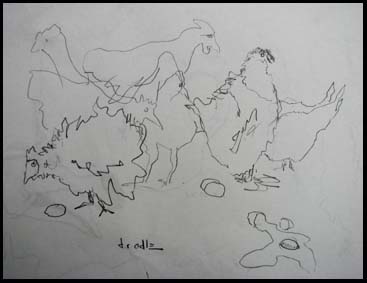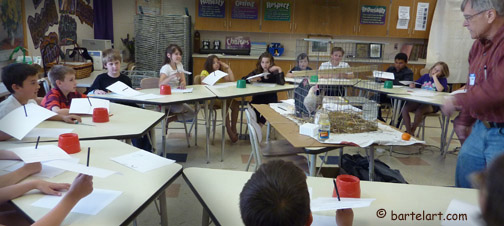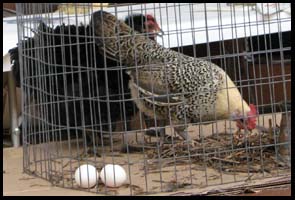Have you ever read the agreement when you installed software on your computer? I read it once. By signing the agreement, I had to promise not to reverse engineer the software code. I was reminded that I was reverse engineering artwork all the time. Am I being a bad boy?
Of course I am taking liberties with terminology. I am really just trying to guess an artist’s intentions, motivations, passions, special methods, and so on. I look at the artwork and speculate about what the artist was thinking. I am empathizing. Of course I am only guessing. Even artists themselves cannot say everything about their own motivations, creative strategies, and so on. By using backward design to teach creativity, we know how we want students to learn to change the ways that they use their minds. We begin with ways to thinking and dispositions we want them to practice. This means we have to find ways to help students generate the right questions, good practice habits, productive ways to respond to mistakes, how to experiment, and so on.
IDEAS FOR ART LESSONS
I use a kind of ‘reverse
engineering’ to plan art lessons. Reverse engineering an artwork allows us to
teach creativity instead of imitation. It provides an unlimited source of
ideas for classroom questions, experiments, play, practice routines, and so
on, for art lessons. This leads to artwork that the students individually
invent instead of stuff that is imitated or copied. It is a way to find the
strategies for students to learn how to invent content and creation
strategies based on their own lives. I am looking for the engineering of the
invention process itself. Of course there are many answers to this. Most
questions that are worth asking and answering have many answers. We can use
and teach this empathic imaginative approach to help our students learn to
experiment, discover, practice, design, persist, self-critique, think, feel,
and express themselves as artists instead of relying on examples,
demonstrations, imitation, or copy work. When I "reverse
engineer" another artist's creative process, I am looking for ways to
start a lesson that can inspire students to think and create from their own
experience, practice, imagine or observe without having to show them the work
of the artist before they do their own artwork. I want to steal the thought
process--not the look of the work. I am looking for the spark
that ignited the artist's imaginative process. If I understand the creative spark and how inspiration
can work, it helps me to invent a way to ignite the imagination of students. I do not want to reverse engineer the reproduction of a particular painting, sculpture, or product. I want to backward design the artist's thinking habits, questioning habits, practice habits, and other aspects of artistic thinking and behavior that has produced innovative and evocative work.
EMPATHY AS ARTISTIC THINKING
Empathy requires imagination. We
may not realize it, but empathy is an intuitive instinct that allows us to
produce artwork that communicates, is evocative, and relevant. I am convinced that empathy
determines much of my studio success, and it also allows me to identify with the intentions of other artists. I used to think that art
teachers needed to be artists themselves so that they would know how to
demonstrate their own production skills. I have now come to
realize that I use empathy as part of my imaginative scenarios about how to
materialize my visual art ideas. Art teachers who are also experienced as
artists may be more able to imagine the secret strategies used to produce great
art examples. Keeping these secrets hidden is the opposite of good
education. WHEN DO STUDENTS FIND OUT WHERE THE LESSON IDEAS ORIGINATED?
After the media work and after
the classroom critique, the students get to see and discuss the actual
professional artwork used by the teacher to design the lesson strategies.
Because they have used the same creativity strategies that may have been
used by the artist, they now have a frame of reference from which to
understand the artist's motivation and strategies. Advanced students are
those who at any age that have become habitually creative and self-motivated
autonomous learners. These advanced students will appreciate the value of
reverse engineering. They too will be able to conjure up reverse engineering
ideas about the work of great artists without being tempted to copy the work
to get a quick rip-off of the product. PRACTICING IT Are you an artist? The next time
you see an impressive work of art, try reverse engineering the thinking and practice routines that produced it. Begin to
imagine the innovative approaches and strategies the artist must have used.
Now imagine yourself, an artist. You bring a whole different set of life experiences. How would you begin? What would you
practice? What kind of playing around would you do? What sort of material
would you be most qualified to work with? What
subject matter would you most likely deal with based on your concerns? Every students has a unique set of life experiences to bring to the act of creation. We are never bored when we actually attain the ability to think creatively. EMPATHIC TEACHING WITH IDEAS FROM REVERSE ENGINEERING
Are you an artist who is also an
art teacher? As you view that impressive work of art, you can imagine the
questions you could ask your students to get them thinking like this artist?
What do your students need to practice? What experiments do they need to do?
They do not need to see the work, but they do need motivation, direction, and
focus. Can we instill motivation by raising relevant and poignant issues? Can
we do this without showing them the work that we used? If we show it to them,
they will see it as answer before the bother to solve the problem. As
students think, respond, experiment, make discoveries, and gain expertise:
their ideas will emerge. We do not need their artwork to have any obvious
visual connections to the artwork we use to plan our approaches. We need
their artwork to be just as authentically theirs as was the work of the
artist we used as a strategic guide. By presenting learning challenges
based on reverse engineering, we can provide students with autonomy (freedom
to be themselves), the means to mastery (good experimental and practice
routines), and encourage them to bring purpose to their work (the ability to
see beyond themselves) by conducting positive empathic critiques. (see Pink below) One of our purposes in being an
artist is to learn how other people feel and think. Without this ability, we
are not successful. Every time we create art, we are empathizing with the
viewers. We are trying to guess how they will see it, what it will mean to
them, and how it will make them feel. We devise design and composition
strategies to make this work. We then discover what works and what fails and
the process repeats itself in an infinite loop. One of our purposes in being an
art teacher is learn to empathize with our students in order to know how to
coach them. In reverse engineering ourselves we understand our own altruism,
our instincts, and why we teach. AN EXAMPLE ART LESSON FROM PICASSO AND BRAQUE In 2007, it was proposed, with
very convincing evidence, that cubism was motivated by the invention of
motion pictures about 100 years ago. “For more than 20
years the New York art dealer Arne Glimcher had carried around a theory, more
gut feeling than scholarly conjecture, that Picasso and Braque had been
seduced by that siren song of the early cinema, and that Cubism, with its
fractured surfaces and multiple perspectives, owed much more to the movies
than anyone had noticed.” (Kennedy) Glimcher is also a
filmmaker and a painter. [Rose] This adds to
his ability to empathize and understand the motivations of Picasso and
Braque. Some secrets of artistic
motivations have taken many years to decipher. For a hundred years the art
critics and art historians had not reverse engineered the story behind
cubism. We can only guess why Picasso and Braque did not choose to reveal the
story of their own inspiration. Artists may realize that their work possesses
greater enigma, mystery, and value when they conceal part of its meaning.
Mark Twain wrote an autobiography, but publication was forbidden until 100
years after his death. Some of his writings on religion are
not to be published until 500 years after his death. TEACHING THE LESSON My cubism lesson begins
with students observing a simple piece of bent wire without looking at the
paper as they draw. (Bartel Cubism) I turn the wire and they draw it again
without looking at their paper on same paper in the same spot on the paper.
This hands-on practice should have no demo and no example for them to see.
They each learn to discover as they their work reveals itself to them. When
they look at their practice lines, they see overlapping bent wire shapes. No
two students are getting the same outcomes, but they are all learning about
cubism, without knowing the word ‘cubism’ they are gaining non-discursive
visual art effects. A few students may notice the representation of time and
motion, but that discussion can wait. Now the lesson becomes more
interesting. From a secret hiding place, I often bring out a live animal two. I use chickens, rabbits, and so on. From their practice, they know what to do
without demonstrations or examples. I simply tell them to fill their papers
with overlapping practice lines that are drawn while looking at the animal.
They are reminded not to look at their paper while the drawing hand is
moving. Each time the animal moves, they are to begin a new line. I reassure them that these are more
practice lines. It is fine for them to overlap and fill the whole sheet. As the papers fill with lines, we
can stop and discuss what is happening and what we can learn about the
passage of time and about motion by looking at these sheets of paper. Instead
of thinking of these papers as pictures, what if we see them as visual
recordings of time and motion? As we look at them as designs, what could we
do to make them into designs or pictures that would be fun to look at?
Students sometimes get good ideas about adding tone, color, texture, or other
elaborations. Here I ask students if they can fill their papers with lines. Each time the chickens move, they may begin another overlapping observed line. Their preliminary practice included the use of a blinder and not looking at the drawing paper while the pencil was in motion. Later the chickens circulate around the tables so that children can add details, texture, tone, and so on as they develp thier drawings. Marvin Bartel, visiting artist, funded by a Dekko Foundation education grant. Josette Abrams, art teacher. North Webster Elementary School, 2010.
The pencil drawing here was made in my adult drawing class. It is a practice observation drawing of two chickens in motion drawn with the instructions to keep drawing in the same space while the chickens are moving. The instructions included the use of a blinder and not looking at the paper while the pencil is in motion. Drawing © Donn Odle 2008 MORE ON REVERSE ENGINEERING, PATENTS, AND COPYRIGHT
Reverse engineering is common
practice in industry among competing companies. When one company or
individual invents an innovative product, the research and development
department of the other companies reverse engineers the innovation. Creative
engineers then improve on it so they can surpass the original invention. It
is a common method of legally stealing patented or (using he first invention
as starting point to invent actual improvements that are substantially
different from the original). One reason for patent law is to
protect the invention for a few years (rewarding the inventor), but another
very important reason for patent law is to overcome secrecy. Every
patent must be published for all to see. You can find out if I or anybody
else has any patents by putting my name in Google Patent Search. You also
search be topics, dates, and so on. A very important purpose of patent law is
to create an open flow of information and knowledge about innovation and
minimize the practice of proprietary secrets. This encourages progress.
Without the patent law requirement of openness, inventors would keep their
innovations secret to avoid copycats. Secrecy would impede progress as it did
for thousands of years. An example would be the secret glaze formulas for reduction
red and crystalline glazes that were never patented. Those who knew how to
produce crystalline glazes demanded high prices for their pottery, but they
did not patent the recipes because they were afraid that others would steal
their secrets. The Chinese knew how to make beautiful porcelain a thousand
years before the Europeans. The Europeans bought the ware and tried to copy
it, but for many years were unable to reverse engineer it. The Japanese
kidnapped the Korean potters in order to find out how to produce high quality
pottery. COPYRIGHTS AND ARTWORK Of course artwork is not
patented, but it is copyright protected as it is made. No registration is
required, although registration may make it easier to protect from violation.
Copyright does not limit use of the ideas or the concepts shown by a work of
art. It only restricts that particular way of rendering the subject, idea,
concept, and so on. Ideas and concepts that are in our minds are free. They
are part of the commons like the air we breathe. When we express ideas in any
form the copyright becomes the property of the person, or group who
materialized it. Of course owners may sell or give
permission and allow others to make copies. To reverse engineer successful
artworks is only an educated guess at best. We are copying any actual work.
We are only trying to guess the ideas behind the process. In the case of art,
we can legally and ethically obtain thinking strategies by imagining the
innovative strategies used by successful artists. We can use the strategies
to make new and different renditions when we figure out how an idea has been
inspired and developed. One method of being a creative art teacher is to be
more competitive in the way we design our lessons to produce more creative
minds in our students. Reverse engineering used in this way can foster
creativity and help our students become the next generation of innovators.
Sources: My doctoral study in
art education included courses with Dr. Phil. Dr. Phil Rueschhoff
studied with Viktor Lowenfeld, author of Creative and Mental Growth. Dr. Phil
had us study all the known research on creativity that we could find. I have come to think of
Lowenfeld, who was a contemporary of B. F. Skinner, as the other side of B.
F. Skinner's brain. Our Dr. Phil introduced us to the notion of teaching art
by beginning with creativity building activities and ending the art-learning
units by having our students study the historic artistic sources of our
strategic thinking strategies.
BIBLIOGRAPHY Bartel, M. (2001) Cubism from
Scratch. http://www2.goshen.edu/~marvinpb/lessons/cubism.html also
see: http://www2.goshen.edu/~marvinpb/lessons/rabbit.html also
see: http://bartelart.com/arted/blindcontour.html Kennedy, R. (2007) “When Picasso
and Braque Went to the Movies.” New York Times, April 15, 2007 http://www.nytimes.com/2007/04/15/arts/design/15kenn.html
Pink, D. H. (2009) Drive: The
Surprising Truth About What Motivates Us. Penquin Group, New York, Pink
explains that autonomy, mastery, and purpose are the three most powerful
human motivators. Rose, C. (2007) “A
discussion about Picasso, Braque and Early Film in Cubism with Bernice Rose
and Arne Glimcher in Art & Design” Friday, June 8, 2007 ” Charlie Rose, © 2010 http://www.charlierose.com/view/interview/8540
[retrieved 12/14/2010] Rueschhoff, Phil H. & Swartz,
M. E. (1969) Teaching Art in the Elementary School: Enhancing Visual
Perception. 1969. The Ronald Press Company, New York, NY, U. S. A.
ISBN: 0471068799 , 339 pgs. If you like this page, try
clicking on Art Education HOME Page by Marvin Bartel DO YOU WORRY ABOUT BURN-OUT It is easy for this happen. For
an art teacher who may be feeling a bit burned out, visiting an art museum and reverse engineering can turn into a whole new approach that can keep ideas flowing for many more works. Students also get burned out and may benefit from chances to imagine, practice, and discover the mental processes of invention (not copying) from another artist. They can try to imitate
similar inspirational strategies, idea generation strategies, refinement strategies, and so on while making artwork that is true to their own experiences, passions, imaginations, and abilities. Students may need
time to review the invention process and discuss how reverse engineering
works. It should always be our goal to make students become independent
learners before they leave our classroom at the end of the term with us. If we train them to copy, we have encouraged a form of "learned helplessness." ALL RIGHTS RESERVED © Marvin Bartel, 2010 author bio You may not publish or place this
page on your web site unless you get permission. Your questions,
suggestions, and comments are appreciated. If you are an art teacher, you may
copy and print the questions for your own use, but not for other teachers.
Send them to this page. CONTACT
the author You are invited to link this page
from your web site. Art Education Home for more essays on teaching art and
creativity updated: January-7-2011
|



